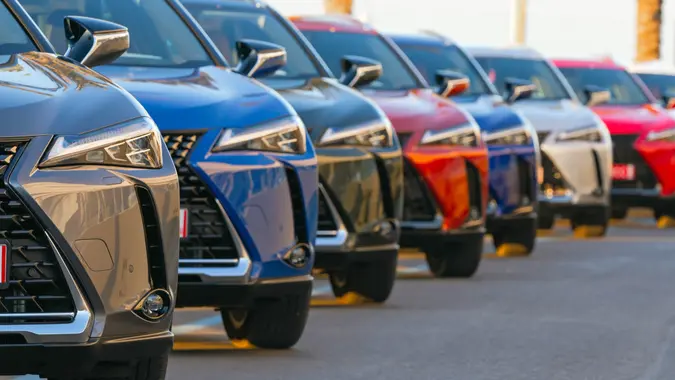Which Generation Is Most Likely To Spend $1,000+ on Their Monthly Car Payment?

Commitment to Our Readers
GOBankingRates' editorial team is committed to bringing you unbiased reviews and information. We use data-driven methodologies to evaluate financial products and services - our reviews and ratings are not influenced by advertisers. You can read more about our editorial guidelines and our products and services review methodology.

20 Years
Helping You Live Richer

Reviewed
by Experts

Trusted by
Millions of Readers
In the United States, the average monthly car payment on a used vehicle is $488, according to the most recent Experian data. In comparison, the average payment on a new vehicle is $644.
As the cost of buying a car increases, so too does the average car payment. While many car owners try to keep their monthly payment as low as possible, some people are willing to spend $500, $700 or even $1,000 or more on theirs.
While trends vary greatly across generations, a recent GOBankingRates survey found that the people most likely to spend upwards of $1,000 on their car payment were those between the ages of 35 and 44 (at just 3.28%). That is, older millennials and younger Gen Xers who are more likely to have more disposable income at hand.
Here’s some additional insight about the average monthly car payment by generation, as well as some ways to lower your car payment.
Overall Insight by Age: Monthly Car Payments
Based on the GOBankingRates survey, here’s an overview of how much people are spending on their car payment by age:
- Ages 18 to 24 (Gen Z): Approximately 34% of people in this age group tend to keep their car payment to $500 or less. Gen Z is also the most likely to spend under $300 on their monthly payment out of all surveyed age groups.
- Ages 25 to 34 (Gen Z to Millennials): Nearly 40% of people in this group spend $500 or less on their car payment. Around 17% spend between $501 and $1,000.
- Ages 35 to 44 (Millennials to Gen X): A large percentage of car owners in this group — around 33% — spend $500 or less on their monthly car payment. This is also the group with the highest percentage of reported car payments over $1,000.
- Ages 45 to 54 (Gen X): About 12% of this age group spend at least $501 on their monthly car payment, while 26% keep their payments lower.
- Ages 55+ (Gen X and Boomers): Individuals in this age group keep their payments lower than other groups, with 72% of people not having a car payment at all.
Working-Age Generations Often Have Higher Car Payments
While they might not necessarily reach the $1,000+ car payment threshold, certain generations — specifically people who are in the middle of their working years — may be more prone to taking on larger auto payments.
“I tend to see that most people in their 30s-40s spend more on their car payments than others. Those younger than 30 may not spend as much, but tend to have a higher percentage of income going towards their car payments,” said Bob Chitrathorn CPFA, CFO, and VP of wealth planning at Simplified Wealth Management.
George Faracchio, VP at Auto Lenders, also observed that younger individuals tend to spend less and increase their budgets as they go.
“Indeed, it’s commonly observed that younger customers typically start their car-buying journey with modest budgets, resulting in lower car payments. As they progress in their careers and establish financial stability, their priorities shift towards specific features or vehicle types, leading to a willingness to spend more on their car payments,” said Faracchio.
At a certain point in life, however, people tend to start spending less on their car payments.
“As individuals approach retirement, there’s often a shift in their mindset,” continued Faracchio. “Many become more budget-conscious and may no longer prioritize the latest models or cutting-edge features as their lifestyles and transportation needs change.”
People May Be Spending Too Much on Their Car Payment
Determining whether someone spends too much on their monthly auto payment is subjective, as everyone’s situation is different. That being said, some experts believe people do spend more than they should on this expense.
“Many customers typically enter the shopping process with a predetermined budget for their car payments. However, many find themselves agreeing to higher payments than initially intended,” said Faracchio. “Among these customers, some exceed their budgeted car payments, and the primary factor contributing to this occurrence is often impulsive decision-making. In many cases, they may be enticed by the allure of pricier vehicles offering appealing features and, as a result, opt to spend more than initially planned.”
Sebastian Jania, owner of Ontario Property Buyers, also indicated that people may spend too much on their car payment. There are several reasons for this.
“The first reason is that people try to drive cars that they can’t really afford just to keep up with the Joneses,” said Jania. “Secondly, many people pay too much for their cars because they don’t properly shop around and negotiate for the best insurance rates or financing rates on their vehicles. The second point is one of the most important as just by being a savvy negotiator, one can pay significantly less for their vehicle.”
Ways To Lower Your Monthly Car Payment
There are several ways to reduce your monthly car payment, but here are some of the big ones.
Pay More Money Upfront and Get a Longer Term
As with a house, having a larger down payment can help lower your total financing costs and your monthly payment amount.
“I usually tell people that you really should put 20% down on your car. This helps lower the amount you have to borrow and therefore your monthly payments,” said Chitrathorn. “You can also get a shorter term, say 4 years, to get a lower interest rate. Or you can get a longer term of 5 or 6 years to spread out your payments over a longer time frame, which will lower your monthly payments. While longer years stretch out your payments over a longer time frame, a shorter term will lower your interest.”
Negotiate With the Dealership and Insurance Company
Negotiating on the price can reduce how much you pay for the vehicle, thereby cutting down your monthly payments.
“When purchasing a car, don’t be afraid to bargain. Negotiating even a few hundred dollars off the purchase price can result in reduced monthly payments,” said Er. Ankit Dhadwal, founder of Mount Shine.
You may also be able to negotiate with the insurance company to lower your monthly premium. “One way to create leverage with both the lender and the insurer is to have additional products with them — such as life insurance when it comes to the insurance company,” said Jania.
Refinance Your Auto Loan
If your current monthly payment is too high, consider refinancing it for a lower amount.
“If you have a high interest rate, refinancing your auto loan can lower your monthly payments,” said Dhadwal. “This works especially well if your credit score has increased since you took out the loan.”
Keep in mind that refinancing may extend or reset your term.
Buy a Cheaper or Used Vehicle
This might seem like an obvious one, but simply going with a pre-owned or less expensive vehicle can significantly cut down on how much you spend on your auto payment every month.
“Purchasing a used vehicle is often a less expensive option than purchasing a new one,” said Dhadwal. “Furthermore, you escape the significant depreciation that occurs in the first few years of a vehicle’s existence.”
More From GOBankingRates
 Written by
Written by  Edited by
Edited by 

























